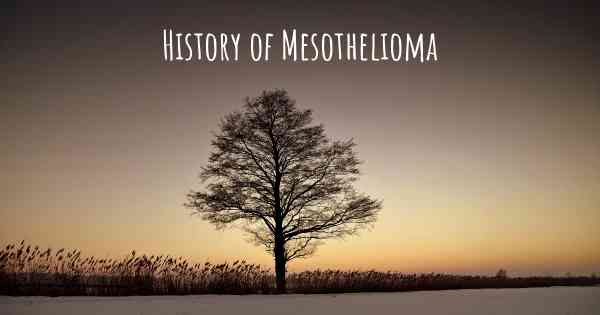What is the history of Mesothelioma?
When was Mesothelioma discovered? What is the story of this discovery? Was it coincidence or not?

Mesothelioma is a rare and aggressive form of cancer that primarily affects the lining of the lungs, abdomen, or heart. It is caused by exposure to asbestos, a naturally occurring mineral that was widely used in various industries for its heat resistance and insulating properties. The history of mesothelioma is closely intertwined with the discovery, use, and subsequent regulation of asbestos.
Discovery of Asbestos:
The use of asbestos dates back thousands of years, with evidence of its use in ancient civilizations such as the Egyptians and Persians. However, it was not until the late 19th century that asbestos gained significant industrial importance. In the early 1900s, asbestos mining and manufacturing industries began to flourish, particularly in Europe and North America.
Early Recognition of Health Risks:
By the early 20th century, reports of health issues among asbestos workers started to emerge. In 1906, the first documented case of asbestos-related disease was reported in the medical literature. However, it took several decades for the link between asbestos exposure and mesothelioma to be fully recognized.
Occupational Exposure and Industrial Use:
During World War II, asbestos use reached its peak due to its widespread application in military equipment and shipbuilding. The mineral's fire-resistant properties made it an ideal material for insulation, protective clothing, and construction materials. As a result, millions of workers were exposed to asbestos in various industries, including mining, construction, manufacturing, and shipbuilding.
Emergence of Mesothelioma Cases:
In the 1960s and 1970s, an alarming increase in mesothelioma cases was observed, particularly among workers with occupational asbestos exposure. Medical researchers and epidemiologists began to investigate the relationship between asbestos and mesothelioma, leading to a growing body of evidence linking the two.
Regulation and Legal Actions:
As the health risks associated with asbestos became more evident, governments and regulatory bodies around the world started implementing stricter regulations. In the United States, the Occupational Safety and Health Administration (OSHA) and the Environmental Protection Agency (EPA) established guidelines to limit asbestos exposure in the workplace and regulate its use in various industries.
Legal actions against asbestos manufacturers and employers also gained momentum. The first successful asbestos-related lawsuit was filed in the United States in 1966, leading to a wave of litigation that continues to this day. As a result, many asbestos companies faced significant financial liabilities and bankruptcy.
Global Bans and Decline in Use:
By the late 20th century, the dangers of asbestos were widely recognized, leading to a global movement to ban its use. Many countries, including the United States, United Kingdom, Australia, and several European nations, implemented strict regulations or outright bans on asbestos. The decline in asbestos use has significantly reduced occupational exposure and subsequently decreased the incidence of mesothelioma.
Ongoing Research and Treatment Advances:
Despite the progress made in understanding mesothelioma, it remains a challenging disease to treat. However, ongoing research and advancements in medical technology have led to improved diagnostic techniques and treatment options. These include surgical interventions, chemotherapy, radiation therapy, and emerging targeted therapies.
Conclusion:
The history of mesothelioma is a testament to the devastating consequences of asbestos exposure. The recognition of the link between asbestos and mesothelioma has led to increased awareness, regulation, and legal actions to protect workers and the general population. While the use of asbestos has significantly declined, the legacy of past exposure continues to impact individuals today. Ongoing research and medical advancements offer hope for improved outcomes and better management of this aggressive cancer.








